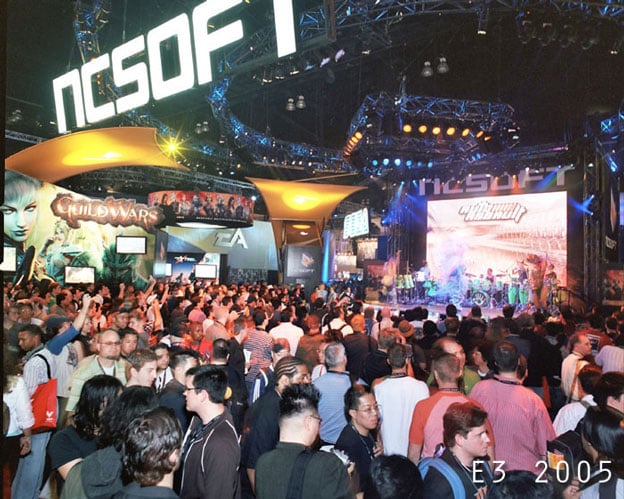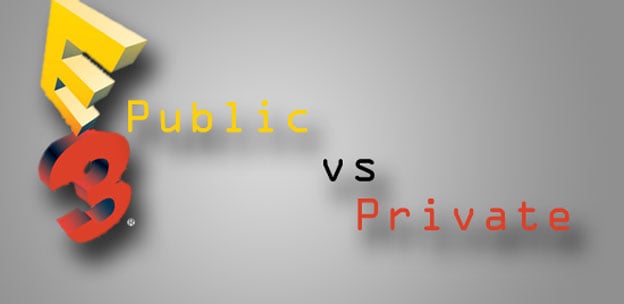Public vs. Private E3
E3, the Electronic Entertainment Expo, is the video game industry’s greatest annual trade show and party. From the time it was founded in 1995 until it reached attendance records of sixty to seventy thousand people in 2005-06, E3 was a relatively public show at which game companies competed heavily with each other for public and press attention. In 2007, E3 was changed into an invitation-only event because its exhibitors complained that competing in the arms race for the best booth was becoming far too expensive. After a few subdued shows, E3 has been returning to its former glory, but remains relatively strict about who is able to attend. Should E3 return to being a public show, or is it better off with a select list of working journalist attendees? Let’s look at the pros and cons of the three stages in E3’s history.

The Public Years – 1995-2006
Although E3 was fairly small when it was founded, it didn’t take long for the show to become quite popular. Every year, an increasing number of people to wanted to attend. After all, E3 had become a favorite place for game companies to announce new hardware and software, and for attendees to test out games and systems before their release.
As the Internet grew, so did the number of people attending E3. Bloggers swarmed the Los Angeles Convention in droves, and plenty of fans who didn’t write about gaming at all had little trouble receiving E3 credentials. E3 became a gigantic party, with companies spending more and more money to attract attention on the crowded show floor. E3 coverage started to focus on crazy stunts, celebrity appearances, and booth babes more than on the video games themselves.
As the show hit attendance records of sixty to seventy thousand in 2005-06, game companies began to cry for mercy. They were spending millions of dollars for show floor space, and felt that the annual arms race to have the best booth or throw the craziest party was taking too much money and time away from actual game development.
The “Walking Dead” Years – 2007-2008
In 2007-2008, E3 was temporarily renamed the E3 Media and Business Summit and moved from June to July. It was seriously scaled back and included a particularly strict invitation list. To quell public demand for a show, a separate E for All show was held in order to give the general public the opportunity to sample new products. E for All never really caught on with game companies or the public, however, and was canceled after 2008.
The new, staid E3 was generally considered a disappointment, even by the companies who had asked for it to be scaled back. Simulation gaming guru Will Wright famously compared the show to The Walking Dead , saying that it seemed like E3 had died several years ago. Gaming publications lost interest in the show, which attracted only 10,000 attendees in 2007 and 5,000 in 2008.

The Happy Medium – 2009-Present
After two years of a scaled-down show that failed to generate much buzz, gaming companies apparently changed their minds about the value of investing in E3. In 2009, E3 relaunched its bigger, fancier format, but it didn’t quite open its doors to everyone. The show’s attendance is still limited to gaming professionals, and gaming publications are given a set number of tickets based on the size of their readership. This year, E3 press applicants needed to prove that they worked for a gaming publication or website, and had written gaming-related articles within the past six months.
A fair bit of the spectacle of E3 has come back, but the more professional crowd has helped keep E3 coverage focused on games and industry news, with the party-style coverage reduced to a footnote on most sites. The argument can be made that this version of E3 is actually more democratic than an open show. Giving actual journalists top priority as attendees means that more gaming information from the show is available to more readers around the world, not just to the people who had the time and money to travel to E3.
Today’s E3 seems to strike a nice happy medium between the old, crazy show and the overly scaled-down show of 2007-2008. It’s big enough to create excitement and buzz without going completely over the top. Now, if only the game companies can rein themselves in enough not to spend too much money on it all, we should have fun and exciting E3s for years to come.
By Becky Cunningham
CCC Contributing Writer
*The views expressed within this article are solely the opinion of the author and do not express the views held by Cheat Code Central.*
